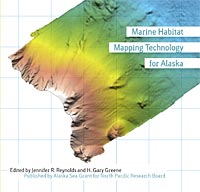
Twenty Years of Fish-Habitat Studies on Heceta Bank, Oregon
Brian N. Tissot, W. Waldo Wakefield, Mark A. Hixon, Julia E.R. Clemons
- Price: Free
 This is part of Marine Habitat Mapping Technology for Alaska
This is part of Marine Habitat Mapping Technology for Alaska| Format | Price | |
|---|---|---|
| PDF download [1.1 MB] Bypass cart and download |
Free | Add to Cart |
Description
Heceta Bank is a major area for commercial fishing off Oregon and provides a wide range of structural habitats for demersal fishes, particularly rockfishes. In 2006, the bank was designated as an Essential Fish Habitat (EFH) Conservation Area closed to bottom trawling. A series of human-occupied (HOV) and remotely operated (ROV) submersible studies focusing on the fishes, invertebrates, and seafloor habitat of Heceta Bank began in 1987, and has largely continued until the present. Early studies focused on characterizing fishes and megafaunal invertebrates and describing the distributions of these assemblages in relation to habitat. As stocks of West Coast groundfish declined, research priorities shifted to a habitat-based strategy to develop methods for estimating the abundance of fishes in untrawlable habitats, identifying fish-habitat associations and potential essential fish habitat, and expanding the inference of the data to larger spatial
scales in order to provide reliable data for fishery management. This shift in priorities coincided with the application of new technologies that provided a detailed multibeam sonar map of the bank, more accurate geographic positioning of the in situ platform (e.g., submersible and support ship), higher resolution video, greater capability to collect samples, and the development of more sophisticated statistical methods. Future research will likely continue to be driven by emerging fishery issues and developing advanced technologies. Research will need to focus on new priorities as they emerge, such as the development of ecosystem-based management, the effects of climate change, and offshore mining and energy development. One of the challenges now is to efficiently relate small-scale observations and assessments of animal-habitat associations collected by direct observations from submersibles and other in situ platforms to the larger geographic scales upon which fisheries operate.
Item details
- Item number: AK-SG-08-03p
- Year: 2008
- DOI: https://doi.org/10.4027/mhmta.2008.15



